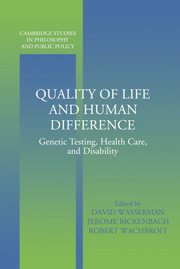Book contents
- Frontmatter
- Contents
- Contributors
- Acknowledgments
- Introduction
- 1 Assessing Quality of Life: Clinical versus Health Policy Uses
- 2 Predicting Genetic Disability while Commodifying Health
- 3 Preventing Genetically Transmitted Disabilities while Respecting Persons with Disabilities
- 4 Disability, Ideology, and Quality of Life: A Bias in Biomedical Ethics
- 5 Values for Health States in QALYs and DALYs: Desirability versus Well-Being and Worth
- 6 Preventing the Existence of People with Disabilities
- 7 Where Is the Sin in Synecdoche? Prenatal Testing and the Parent-Child Relationship
- 8 The Social Context of Individual Choice
- 9 Disability and Health Systems Assessment
- Index
2 - Predicting Genetic Disability while Commodifying Health
Published online by Cambridge University Press: 03 December 2009
- Frontmatter
- Contents
- Contributors
- Acknowledgments
- Introduction
- 1 Assessing Quality of Life: Clinical versus Health Policy Uses
- 2 Predicting Genetic Disability while Commodifying Health
- 3 Preventing Genetically Transmitted Disabilities while Respecting Persons with Disabilities
- 4 Disability, Ideology, and Quality of Life: A Bias in Biomedical Ethics
- 5 Values for Health States in QALYs and DALYs: Desirability versus Well-Being and Worth
- 6 Preventing the Existence of People with Disabilities
- 7 Where Is the Sin in Synecdoche? Prenatal Testing and the Parent-Child Relationship
- 8 The Social Context of Individual Choice
- 9 Disability and Health Systems Assessment
- Index
Summary
IS HEALTH A RESOURCE?
Is health a crucial resource for succeeding in everyday life? Public health policy makers speak as if this were so, both for individuals and for the community as a whole. As a World Health Organization document states: “Health is therefore seen as a resource for everyday living. … it is a positive concept emphasizing social and personal resources. … ” And a Canadian government report explains: “Health is thus envisaged as a resource which gives people the ability to manage and even to change their surroundings.”
It seems obvious to them, first of all, that citizens whose health is, or is likely to be, compromised are unfortunately (and possibly inequitably) limited in their pursuit of deserved opportunities and ends. Second, the presence or prospect of numerous citizens whose health is, or is likely to be, unusually compromised likewise seems obviously to limit a society from the collective realization of desirable social conditions and goals. This way of speaking about health commodifies it. On this conception, health resembles wealth. For individuals who possess it, health is a personal asset that enables productive interaction with the people and things that surround them. Its value, therefore, is instrumental. For societies, citizens' health is treated as a collective asset that is instrumental for achieving the general good.
- Type
- Chapter
- Information
- Quality of Life and Human DifferenceGenetic Testing, Health Care, and Disability, pp. 43 - 66Publisher: Cambridge University PressPrint publication year: 2005
- 5
- Cited by



